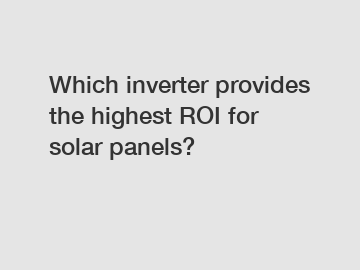Feb. 02, 2024
Energy
Which inverter provides the highest ROI for solar panels?
As the demand for renewable energy continues to soar, more and more homeowners are turning to solar power to meet their electricity needs. Solar panels have become increasingly popular due to their eco-friendliness and long-term financial benefits. However, one crucial component that determines the efficiency and profitability of a solar energy system is the inverter. In this article, we will delve into the various types of solar inverters available and discuss which one provides the highest return on investment (ROI) for solar panels.
1) String Inverters: One of the most widely used options, string inverters, are cost-effective and straightforward. These inverters are connected to a string of multiple solar panels, converting the DC (direct current) electricity generated by the panels into AC (alternating current) electricity suitable for home use. However, string inverters suffer from a common limitation known as the "Christmas light effect." That means if one panel is partially shaded or malfunctions, it affects the performance of all the panels connected in that string, leading to decreased efficiency and lower ROI.

2) Microinverters: To address the shading issue of string inverters, microinverters were introduced. Unlike string inverters, microinverters are installed on each individual solar panel, eliminating the "Christmas light effect." This ensures that the output of each panel is independent of others, maximizing energy production even in partially shaded or mismatched panels. Microinverters may have a higher initial cost compared to string inverters, but they offer increased system reliability and higher overall energy yield, ultimately resulting in a greater ROI.
3) Power Optimizers: Power optimizers are yet another option for improving the efficiency of solar panels. Similar to microinverters, power optimizers are installed on each panel, allowing for panel-level MPPT (maximum power point tracking). MPPT enables each panel to operate at its maximum efficiency independently. Power optimizers, when paired with a central inverter, provide the benefits of panel-level optimization while maintaining the simplicity and cost-effectiveness of a string inverter. This combination ensures higher energy production, especially in instances of shading or panel mismatch, leading to a better ROI compared to traditional string inverters.
4) Hybrid Inverters: Hybrid inverters are an emerging technology in the solar industry. These inverters not only convert DC electricity to AC but also integrate energy storage systems, allowing excess solar energy to be stored for later use. Hybrid inverters provide the capability to harness solar power while also having a backup power source during blackouts or when solar energy generation is insufficient. This additional functionality of hybrid inverters enhances the ROI by maximizing self-consumption and reducing reliance on the grid.
Considering the options mentioned above, microinverters, power optimizers, and hybrid inverters appear to offer a higher ROI for solar panels. The independent panel-level optimization provided by microinverters and power optimizers ensure maximum energy production even in suboptimal conditions, such as shading or panel mismatch. While microinverters have higher upfront costs, their increased reliability and energy yield offset the initial investment, resulting in a better long-term ROI. Power optimizers, combined with a central inverter, provide a cost-effective solution with improved energy production. On the other hand, hybrid inverters excel in maximizing self-consumption and reducing reliance on the grid, offering additional benefits like backup power during outages.
In conclusion, choosing the inverter that provides the highest ROI for solar panels involves careful consideration of the specific needs and circumstances of each homeowner. While string inverters are a popular choice due to their affordability, microinverters and power optimizers offer improved performance in shaded or mismatched conditions. Meanwhile, hybrid inverters combine the advantages of solar energy generation and energy storage, further enhancing the economic viability of solar power systems. It is essential to consult with solar energy professionals to determine the most suitable inverter technology for each unique situation, ultimately leading to optimal financial returns and greener energy consumption.
If you want to learn more, please visit our website china solar inverter manufacturers, 3 phase inverter for solar panels, hybrid inverter manufacturer.
If you are interested in sending in a Guest Blogger Submission,welcome to write for us!
All Comments ( 0 )